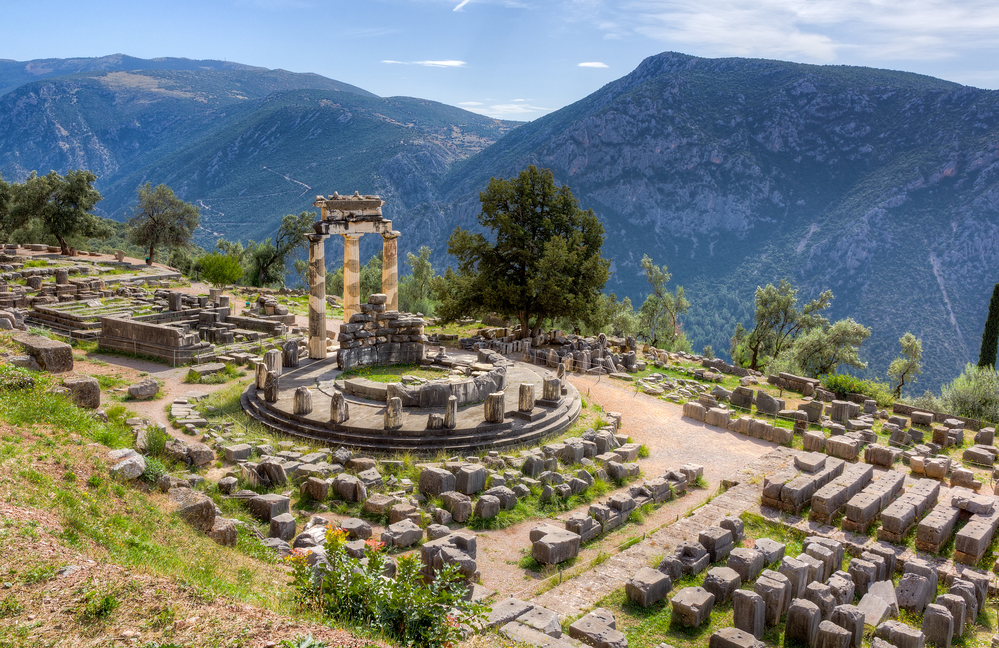People having been coming to Delphi for thousands of years of Greek history and the ancient footpaths they used are still in existence.
by Janet McGiffin
Janet McGiffin is the author of the four-volume Empress Irini series about the 8th Century Byzantine Empress Irini who was one of two women to hold the throne in her own right. Janet can be reached through her website, Janetmcgiffin.com
Dropping gently down the slopes of Mt Parnassos from the Corycean Grotto to the village of Delphi is one of the
loveliest day-hikes in the Mediterranean. This well-marked, mapped, 13.7 km route down the mountain sacred to Apollo
and Dionysos is a blend of two historic footpaths. One is the Ancient Footpath (Archaio Monopati) that took Pan
worshippers up from the ancient temples of Delphi to the Corycean Grotto to celebrate rites of Pan. The second
footpath is the European Union E4 Long Distance Footpath that passes over Mt. Parnassos on its way from Gibraltar
to Crete.
The Archaio Monopati may be the oldest still-used footpath on the planet. Hewn out of the rock face of Mt. Krokos
that rises behind the Delphi archeological site, and wide enough for a donkey cart, the Archaio Monopati led Delphi
residents to the Grotto both for Pan and Dionysian worship, and to hide during the Persian invasion, the War of
Independence, and during World War II. Delphi itself has been inhabited from 1400 BC.
The E4 Footpath is modern history. As part of the open border agreements of the 1990s, the European Footpaths Commission
worked with the countries of the EU to set up twelve cross-Europe footpaths, each publicized and maintained by
member countries. Two EU Footpaths cross Greece. The E6 travels east-west from Igomanitsa on the Ionian Sea to
Alexandropoli near the Turkish border. The E4 travels north-south from Florina near Albania to Gythio at the tip
of the Pelopponese, then skips to Crete.
The E4 crosses the west flank of Mt. Parnassos on the saddle between Mount Giona and Parnassos, at the "51st
Km", the highest point of the Lamia-Amfissa Road. The route then passes under the summit to the village of
Eptalofos (Agoriani) and meanders down to Delphi with side-trips to various monasteries. Just above Delphi, the
E4 merges with the Archaio Monopati coming from the Corycean Grotto.
|
|
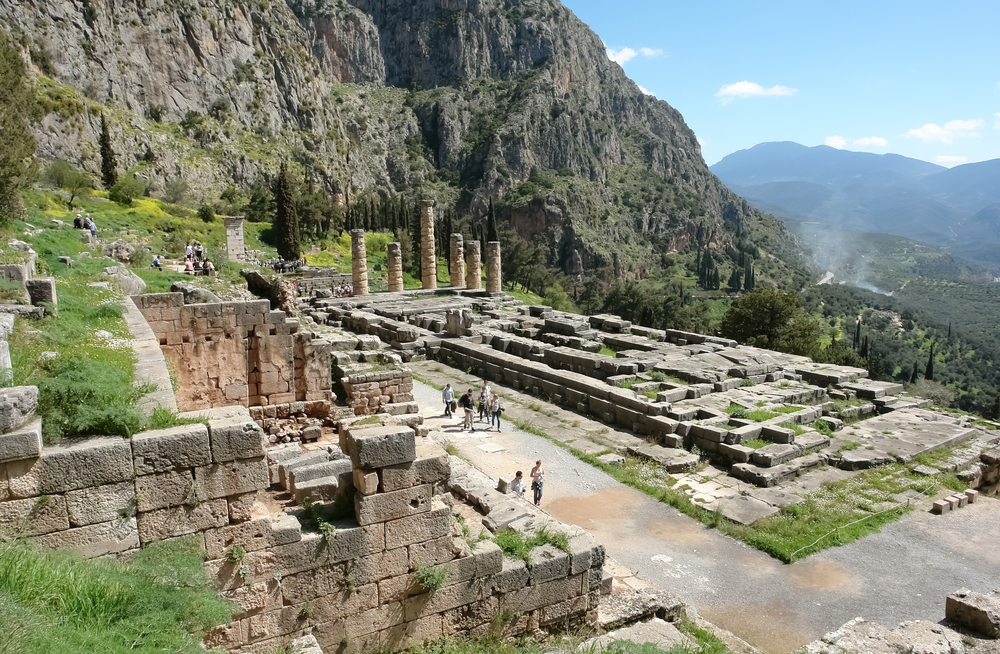
|
|
While ancient Greeks worshiping Pan may have wanted to struggle upward to purge their souls, modern hikers can
enjoy the Archaio Monopati and the E4 more by hiking downward-taking a taxi from Delphi for about 45 minutes (around
15 Euros) up Mt. Parnassos to near Kalivia on the Arachova-Agoriani road. A sign indicates the footpath to the
grotto. (After passing through a meadow, a sign points right, up a steep slope to the grotto.) Alternatively, a
pleasant dirt road leads directly to the grotto, a half-hour walk.
The dusky and cavernous Corycean Grotto has a satisfying murky echo. Stalactites and stalagmites loom up in the
gloom. Named after korikos, a boxing-sack, the Grotto was a cult shrine in Neolithic and late-Mycenaean times.
French archeologists in 1970 found cult statuettes, vases, coins, rings, and engravings to Pan and the Nymphs estimated
to be 4th to 6th century BC. Above the cave were the Dionysian orgies.
Mornings in late fall or early spring may be foggy or it may appear to be raining on the mountain. Appearances
can be deceiving. Drive to the start-off point before making weather decisions. In any case, the hike along the
road to the cave is less than an hour. A taxi driver might wait. Or the road can be negotiated by taxi, driver
willing. On one Easter hike, we set out in light fog with snow patches but glimpses of Parnassos through the clouds
showed a sunny peak. Before long it was shirtsleeve weather.
From the Corycean Grotto downward to Delphi, the path starts with a sharp descent to pick up the trail leading
west. From then on, the grade is gently downward with occasional mild rises. Blazes in black on yellow or red expertly
mark the route. At the entrance to Mt. Parnassos National Park, the path passes an information center in a meadow
where cattle are pastured.
|
|
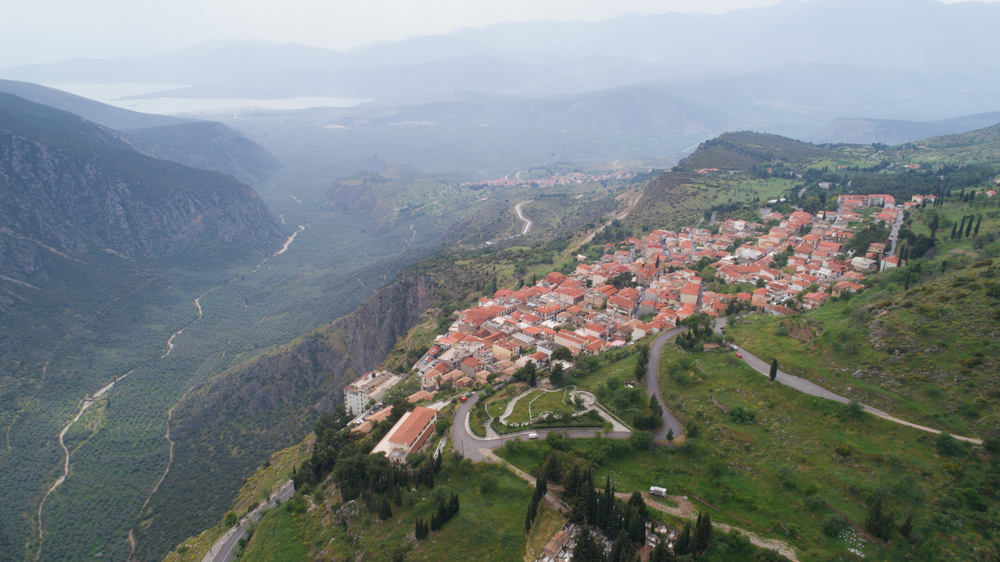
|
|
ORGANIZING THE TRIP
Plan for two nights in Delphi, arriving the afternoon before your hike. From Athens, Intercity buses leave from
Terminal B on Liossion Street. But there is a lot to see in the area and renting a car may be your best option for exploring. See www.greektravel.com/swift
You can also go by private
Taxi from Athens.
See www.greecetravel.com/taxi
LODGINGS AND MEALS
Rooms
are always available, although Delphi can be crowded in summer and in winter some hotels open weekends only. South-facing
rooms overlook the dramatic Pleisto River Gorge and the Peloponnese. Delphi dining is family tavernas serving country
fare. Or there is souvlaki at two locations on the main street.
Lodging can also be had in Itea, or Galaxidi on the Gulf of Corinth below Delphi. Arachova, above, is larger and
more touristy, and known for picturesque lanes, spectacular views, hotels that also cater to skiers, and the monastery
of Ossias Loukas. However, if you've come to hike the Ancient Footpath, your destination will be Delphi, and it's
a charming experience to descend the last flight of steps through the town just as the sun is setting, and stroll
straight into your hotel. For information and hotels in the towns around Delphi see Matt's Around Delphi Page
TAXI UP THE MOUNTAIN
Reserve your taxi the afternoon before your hike. The taxi stand at the east end of Delphi sometimes has taxis
parked there. Or ask your hotel clerk to order a taxi. Pull out your hiking map, point to the Corycean Grotto (Korikio
Antro) and say you want to leave around nine the next morning.
MAPS
Several Greek mapmakers publish excellent hiking maps of Mt. Parnassos (and all of Greece) in Greek and English
with detailed information about the hikes and regional history. Maps are found at Athens' bookstores, outdoor equipment
stores, or tourist sites. The Delphi bus station (the souvlakeria at the west end of Delphi) sometimes has hiking
maps.
|
|
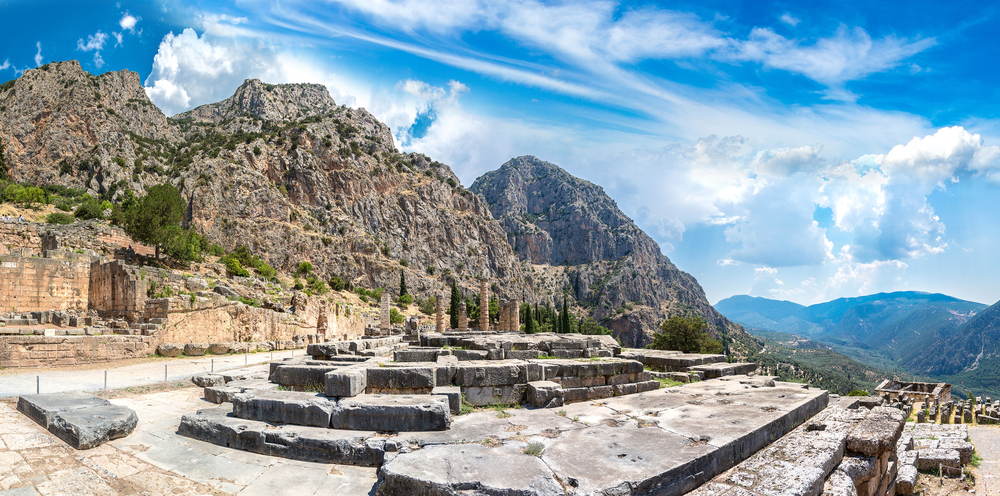
|
|
In Greek mythology, Mt. Parnassos was named after Parnassos, a son of Poseidon and the nymph Leonora. Parnassos
founded the old oracle of Pith and could tell the future by observing the way birds flew. The mythology gets complicated
after that, involving Apollo, Hera (queen of the gods) and a nasty serpentine dragon whom Hera liked named Python
who lived by the Kastalia springs at Delphi and destroyed men and beasts. The cult of Apollo eventually took over
and resulted in the Oracle of Delphi and her famous predictions. In a parallel myth, Dionysos, son of Zeus and
Persephone, lived on Parnassos and was pursued by Hera. Complications of Greek mythology aside, there's definitely
something about this part of the "Middle Earth" that puts Delphi on the maps of even eastern religions
who consider it an energy point of the universe.
Mt. Parnassos National Park was set up in 1938, 36 million square meters of protection for the unusual ecosystem
of the mountain. Bauxite deposits are plentiful and Parnassos bauxite remains the main primary material for Greek
aluminum production. Below 700 meters of altitude grows Mediterranean vegetation which needs little water-thyme,
oregano, Holm-oak, cedar, arbutus, laurel, lentisk. Olive groves carpet the foot of the mountain, especially in
the Pleisto River valley below Delphi and the Itea plain. Between 700 and 1,000 meters grow forests of pine and
Kephallonian firs with their sharp needles. Above timberline is little but rock.
Depending on bird migration patterns, hikers may see thrushes, linnets, woodpeckers, and robins. Higher are orioles
and birds of prey that nest among the rocks such as vultures, harrier eagles, and golden eagles.
The trail meanders through woods that are masses of bright leaves in autumn, and glades that are carpeted with
wildflowers and snow patches in spring. Small waterways are the water sources for Delphi and the Kastelia Springs
by the archeological site. Lovely views open unexpectedly to Mt. Parnassos and the mountains to the West. The trail
merges occasionally with a dirt road, then veers again into woods.
Armed with a map, the hiker can choose between two routes. One leaves the Archaio Monopati shortly after the National
Park entrance and heads west to catch the E4 trail. The second route follows the Archaio Monopati and slope south-west
to merge with the E4 lower down. Either route is many quiet hours of encountering virtually no other person. The
changing topography and varied vistas are perfect for making regular stops for photos, watercolor painting, and
picnics. Hours of walking pass swiftly and without seeming effort.
The arrival at the top of the cliff above Delphi is so abrupt as to be startling. From a tunnel-like gully lined
with white rocks, the vista explodes outward. If the timing has been right, the sun is just lowering over the Ionian
Sea, silhouetting the mountains to the west. To the south, the Gulf of Corinth is a slice of silver below the purple
mountains of the Peloponnese. To the left are the twin Phaedriades (Shining Rocks) so called because they reflect
the light. There the ancients threw off people convicted of sacrilege. Straight down are the tiny red tile roofs
of Delphi and the final zig-zags of the Archaio Monopati.
|
|
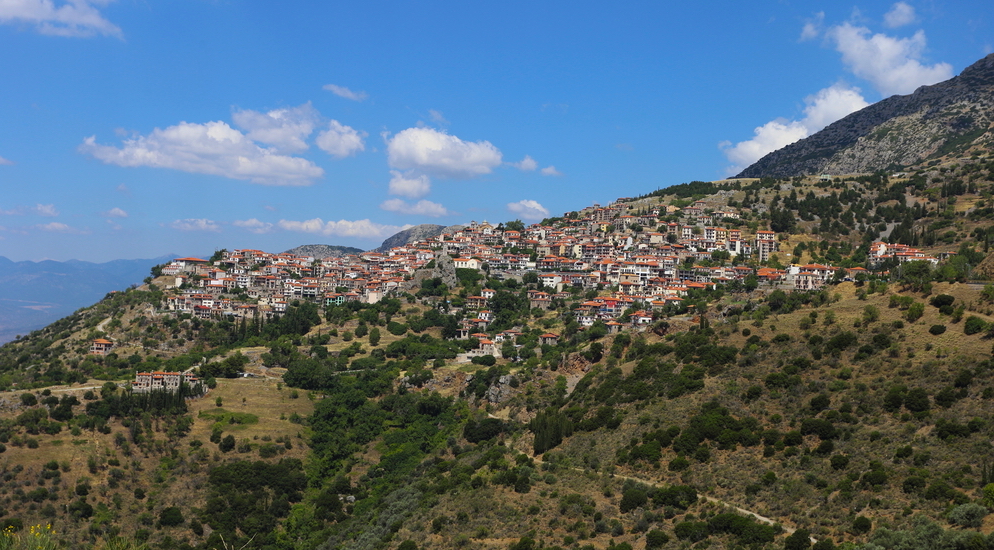
|
|
OTHER HIKES AROUND DELPHI
(I have not taken these but they are well mapped and described in hiking guides)
"For continuing up Mt. Parnassos from the Corycean Grotto, the ascending footpath is picked up at Kalivia
where the trail crosses the Arachova-Agoriani road (the same drop-off for the Grotto-to-Delphi hike). This marked
and mapped footpath proceeds upwards to the village of Livadi, the mountaineering club shelter, and the Tgerontovrachos
hills, crossing the winter sports centers. Two detours lead to the Parnassos and Liakoura Gerontovrachos peaks.
The path descends through the Velitsa Gorge to the village of Tithorea.
"A second route follows the path taken in the old days by the villagers of Arachova and Apo Souvala to ascend
to the higher slopes of Parnassos. This path is said to be partly destroyed.
"Hikers can walk the entire Parnassos portion of the E4, starting at the "51st Km" and ending at
Kirrha on the Gulf of Corinth. The distance is approximately 60 km and could be walked in three days with overnights
in Agoriani, Delphi, and Kirra.
"A pleasant day-walk would be to do the final segment of the E4 from Delphi to Kirra. This was the route
taken by pilgrims to the Delphi Oracle. Kirrha has an interesting history. About 590 BC, several Greek city-states
joined to protect the sanctuary of Delphi. According to one historian, they attacked Kirrha which controlled the
road to Delphi. Kirrha had appropriated land considered sacred to Apollo and had mistreated pilgrims. Following
an edict from the Oracle of Delphi to destroy the town, the commander of the siege cut the water-pipes leading
into the town. When townspeople were suffering seriously from thirst, he turned on the water again, but poisoned
with hellebore. The ensuing diarrhea so weakened the town that it was overcome.
"To the Sybaris Cave and the Pleisto Gorge. This descends an earth road leading from the main road East of
Marmaria. Some guidebooks have details.
Janet McGiffin lives in Athens partly because it is so easy
to travel to anywhere from Greece. She is a writer of mystery novels and travel
articles. She also writes grant proposals for non-profit organizations (NGO)
based around the Mediterranean. Currently she is public-education publicist for
a 24-partner European Union cultural project involving conservation of ancient
monuments. You can e-mail her at
mcgiffin@otenet.gr
For more on Delphi see Matt's Guide to Delphi
For Hotels and rooms in Delphi contact one of Matt's recommended Greek Travel Agencies
|
|

